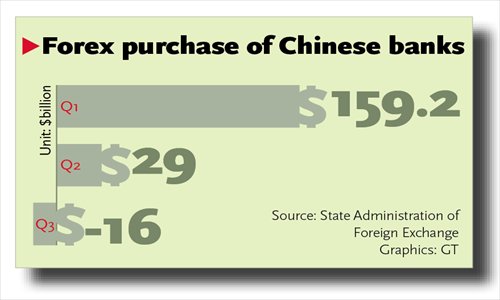Foreign exchange market balanced: official
SAFE allays concerns over capital outflow

A currency exchange store in Shenzhen, South China's Guangdong Province Photo: CFP

China's foreign currency regulator Thursday dismissed market concern over signs of foreign capital outflows, saying a recent deficit in foreign exchange transactions is a market reaction driven by a more liberalized currency regime.
"Despite monthly fluctuations, the overall foreign currency demand and supply is balanced," Guan Tao, head of the department of international payments at the State Administration of Foreign Exchange (SAFE), said at a press conference on Thursday.
Chinese banks had a deficit in foreign exchange transactions of $16 billion in the third quarter of this year, indicating a trend of foreign capital outflow, after recording a net inflow of $159.2 billion in the first quarter and $29 billion in the second quarter, the SAFE's latest data showed.
For the January-September period, the banks bought $1.43 trillion and sold $1.25 trillion worth of foreign currency, indicating a net capital inflow of $172.3 billion.
It is hard to conclude that foreign capital is flowing out of China only based on the quarterly fluctuations in the banks' purchase and sale of foreign currencies, Lian Ping, chief economist at Bank of Communications, told the Global Times on Thursday.
The short-term deficit in bank's foreign exchange transactions could be the result of increasing outbound direct investment (ODI) by domestic firms which exchanged yuan into foreign currency to pay for overseas assets, Lian said.
China posted a stronger ODI growth of 21.6 percent in the first three quarters from a year earlier, according to the Ministry of Commerce.
Another sign of foreign capital outflow was the country's foreign reserves which stood at $3.89 trillion by the end of the third quarter, down $105.5 billion from the second quarter.
Due to a stronger dollar, the value of non-dollar currencies in the foreign reserves fell compared with the dollar, leading to a nominal drop in the value of reserves but not an actual loss, and has nothing to do with the cross-border capital movement, SAFE's Guan noted.
The slowdown in the growth of outstanding foreign reserve is in line with the country's policy goals, reflecting a more balanced international payment sheet, he said.
Non-financial institutions and residents are now willing to hold on to foreign currency rather than selling to banks, which is a natural market reaction to a more flexible exchange rate regime, according to the SAFE official.
The central bank doubled the daily trading band of the yuan against the US dollar to 2 percent in March as part of its commitment to let markets play a greater role in the economy. The move indicates a greater volatility in the value of the yuan against other currencies.
The yuan depreciated against the dollar in the first five months by about 3.4 percent but the trend reversed in the middle of the year when the Chinese currency has floated in the range of 2.2 percent till now, and the greater movement leads to a mixed view on the future course of the yuan.
Despite the rebound in the yuan in recent months, enterprises tend to keep foreign currency and cut foreign debt to ward off potential risks.
SAFE's Guan confirmed earlier reports that Chinese listed firms incurred losses of 11.7 billion yuan ($1.9 billion) worth of foreign exchange in the first half of this year.
Enterprises hold different view of the future trajectory of the yuan, which is good as it shows the effect of a market-driven rate, Liu Dongliang, a senior financial analyst at China Merchants Bank, told the Global Times on Thursday.
"Unlike in the past when enterprises bet on the rise of the yuan in a single direction, now they are more cautious as they are uncertain about the further rise of the yuan and concerned about China's economic slowdown," Liu said.
China's economy grew 7.3 percent in the third quarter from a year earlier, slower from 7.5 percent from the second quarter, official data showed on Wednesday.
Pressure on the yuan's depreciation against the US dollar will emerge in the first half of 2015, when the US Federal Reserve may completely withdraw from its quantitative easing program and even start raising interest rates, analysts said.